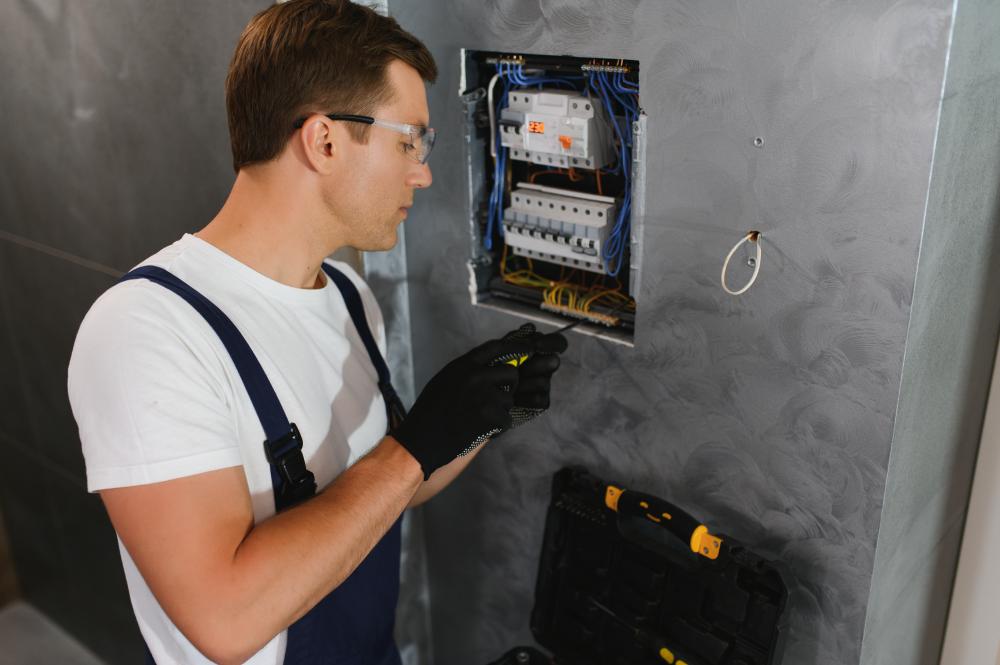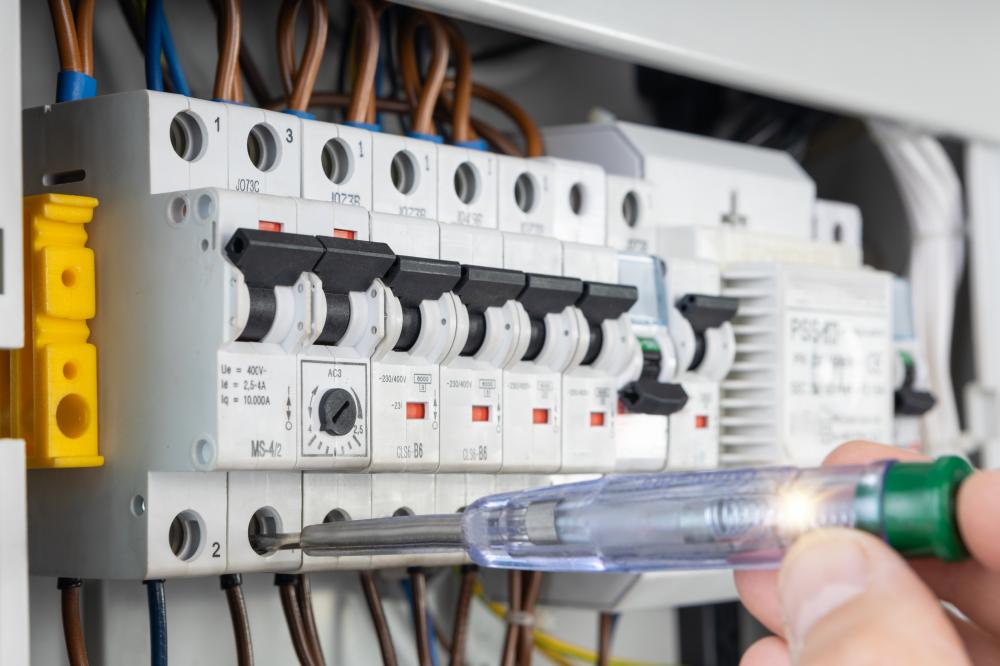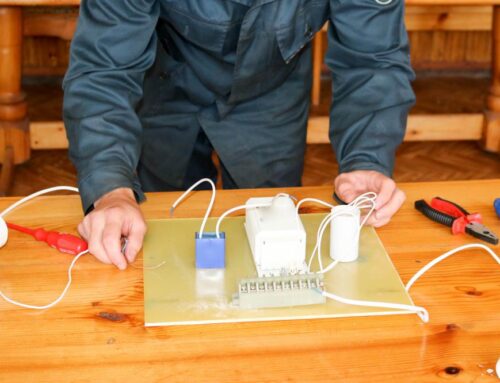
Understanding Circuit Breakers
As an electrician in Beverly Hills, I've seen the frustration a tripped breaker can cause. Knowing how to reset a tripped circuit breaker is key to resolving most power interruptions. Circuit breakers are crucial for protecting your home from electrical overloads and short circuits. They cut the power supply when they detect issues, safeguarding against electrical fires.
Understanding why your breaker trips is the first step. Overloading the circuit by plugging in too many devices is a common cause. Short circuits, where wires unintentionally touch, can also trip the breaker. Identifying these issues helps prevent future occurrences.
Once you know how to reset a tripped circuit breaker, you can restore power swiftly. But it's essential to ensure you won't damage your electrical system in the process. Always prioritize safety with any electrical work.
Preparing to Reset a Tripped Circuit Breaker
You should begin by turning off all devices connected to the affected circuit. This prevents further overload once the power is restored. Finding the main electrical panel is the next step. It's often located in a garage, basement, or utility closet. Make sure you have a flashlight, as panels are sometimes in dimly lit areas.
Safety is paramount. Wear rubber-soled shoes and safety glasses if available. This reduces the risk of electrical shock. If the panel feels hot, it's wise to consult a professional. We at Beverly Hills Electrician Pros have dealt with plenty of overheated panels, and it can indicate a more serious issue.
Steps to Reset a Tripped Circuit Breaker
With safety precautions in place, it's time to reset the breaker. Open the service panel door and locate the tripped breaker. It often sits in a middle position between off and on. To reset, push the handle firmly to the “off” position. Next, return it to the “on” position. You should feel a click indicating it's securely back in place.
Testing the circuit is crucial. Turn on a single low-power device first. If the breaker holds, gradually reintroduce other devices. If it trips again, there may be a deeper issue requiring a professional's attention. Our team frequently assists in these scenarios, ensuring the safety and reliability of your electrical system.
Troubleshooting and Prevention
If resetting the breaker doesn’t resolve the problem, further troubleshooting might be needed. First, check for any damaged cords or plugs that could cause a trip. Ensure the circuit isn't overloaded with high-power devices. Distributing devices across different circuits can relieve the load.
Installing GFCI outlets is another preventive measure. While they don't protect from overloads, they do shut off power in the event of a ground fault. This adds another layer of safety. Replacing old light fixtures and faulty wiring can also prevent frequent trips.
At Beverly Hills Electrician Pros, we often recommend regular inspections. This helps catch potential issues before they become significant problems. Keeping your electrical system in top condition ensures both safety and functionality.

Understanding Circuit Breaker Issues
At Beverly Hills Electrician Pros, we often encounter diverse circuit breaker problems. Circuit breaker troubleshooting is a process that starts with understanding the root causes. Overloads, short circuits, and electrical faults are just a few examples. Recognizing these issues early can prevent further damage. We emphasize this during each callout, sharing insights with homeowners.
Experience has taught us that overloaded circuits are common culprits. Connecting too many appliances can tip the balance. The tendency to overlook device amperage ratings adds to this issue. Educating clients about proper usage has been our priority. Circuit breaker troubleshooting becomes significantly simpler once homeowners know the limits of their circuits.
Identifying Warning Signs
Flickering lights or humming noises are signals that shouldn't be ignored. These are classic indicators of underlying issues. Our professional experience tells us these signs often precede circuit breaker trips. Lights that flicker when appliances power on or a persistent hum from the breaker box can spell trouble.
While these may seem harmless, they are often warnings of significant risks. Over time, they might lead to equipment damage or even fires. Circuit breaker troubleshooting often begins with listening. Those subtle sounds can guide us to potential problems before they escalate.
Additionally, checking for loose wires is crucial. Sometimes, poor connections are to blame. Addressing these issues promptly is vital for circuit breaker troubleshooting. Don’t delay in reaching out if you notice these signs.
Practical Troubleshooting Steps
Resetting the circuit breaker is often the first step. This simple action can resolve many minor issues. However, if the problem persists, diving deeper is necessary. An essential aspect of circuit breaker troubleshooting is inspecting your appliances. We recommend checking cords for damage. A burnt or frayed wire could signal a short circuit.
Balancing the load across circuits can also help. Move high-demand appliances to different circuits. This step reduces the risk of overload. We’ve seen this seemingly minor adjustment work wonders in numerous homes. By understanding the power requirements of each device, homeowners can prevent issues before they occur.
Lastly, recognize when to call in a professional. If reset attempts fail or sparks appear, it’s time to call experts. Avoiding further damage should always be the priority.
Importance of Routine Maintenance
Routine maintenance is a vital component of circuit breaker troubleshooting. Regular inspections can help catch malfunctions early. At Beverly Hills Electrician Pros, we emphasize the importance of preventive care. A well-maintained system is less likely to encounter unexpected failures.
We advise checking circuit breaker panels periodically. Look for any signs of wear or corrosion. Replace outdated equipment to ensure safety. Staying proactive can save both time and money in the long run.
Conducting a thorough inspection can also reveal potential issues. By engaging in routine maintenance, homeowners can achieve optimal electrical efficiency. Trust us—small efforts today can prevent big headaches tomorrow.
Through these strategies, circuit breaker troubleshooting can transform from a challenging task into a manageable one. Our commitment is to make homes safer through professional guidance and expert service.
Understanding Electrical Safety
As a team with vast experience, we’ve seen how electrical safety can sometimes be overlooked in everyday life. It's not just about knowing the basics, but truly understanding how to apply them. The first rule of electrical safety tips is to be wary of water. Water and electricity never mix well, and simple precautions can prevent accidents. We always remind customers to keep appliances away from sinks and bathtubs.
In our work, we emphasize the importance of grounding as well. Grounding ensures a path for excess electricity, preventing shock hazards. Proper installation and routine checks are vital. Our team ensures every home’s electrical system is correctly grounded, giving peace of mind.
The Danger of Overloading
Homeowners often unknowingly overload outlets, leading to potential fire risks. Overloading occurs when too many devices are plugged into a single outlet. We advocate using smart plugs to monitor and manage electrical loads effectively. Recognizing when an outlet is overloaded could save lives, which is why regular checks are part of our electrical safety tips.
Our electricians are always ready to install additional outlets if needed. This is often a safer solution than relying on multi-outlet converters. Always remember, safety should never be compromised. Trust us to assess your home’s needs accurately.
Revisiting the basics, we suggest unplugging appliances when not in use. This reduces phantom loads, saving energy and reducing overheating risks. Simple actions can make a huge difference. Turn this into a habit for better electrical safety.
Regular Maintenance Inspections
One key to ensuring electrical safety is regular maintenance. Our team provides thorough inspections, identifying potential issues before they become hazardous. Loose wiring or corroded connections are common problems we uncover, underscoring their importance.
During inspections, be sure to check wattages on all fixtures. Improper bulb usage is a hidden danger many neglect. We recommend using LED bulbs, which are energy-efficient and reduce overheating risks. These simple changes can enhance safety significantly.
We also stress the need to clean exhaust fans regularly. Build-up in fans can lead to overheating and fire risks. Ensuring proper ventilation keeps your home safe and appliances functioning optimally. We prioritize these checks during our visits.
Safety for Kids
As electricians and parents, we understand the importance of electrical safety for kids. Outlets are intriguing to children, so installing safety caps is essential. These caps prevent accidental shocks and are one of the most effective electrical safety tips for families.
Educating children is equally important. Teach them the dangers of pulling cords or tampering with outlets. Simple lessons can prevent accidents. We believe early education on electrical safety can instill lifelong habits.
Finally, it’s crucial to keep electrical appliances out of reach. Toasters, kettles, and other gadgets should be stored safely. These are simple yet effective measures that greatly reduce risks.
Advanced Precautions
For those already familiar with basic electrical safety tips, advanced precautions can offer additional protection. Installing smoke detectors is critical as electrical fires can often go unnoticed. Smoke detectors provide early warnings, and regular checks ensure they remain functional.
In the event of severe weather, knowing how to protect your home’s electrical systems is important. We provide advice on protecting appliances from power surges and ensuring standby generators are safely operated. Preparing ahead minimizes risks.
Lastly, ensure you have a trusted professional on hand for emergencies. Our team is available 24/7, ready to assist and address concerns promptly. For any electrical safety tips, don’t hesitate to reach out. Your safety is our priority.

How do you fix a tripped breaker that won't reset?
If a breaker won't reset, it's often an indicator of a deeper issue that needs attention. At Beverly Hills Electrician Pros, we've encountered this scenario many times, and our first step is always to ensure safety. Ensure all devices on the circuit are unplugged to prevent further overload. Sometimes, a persistent fault in the circuit, such as a short circuit or ground fault, might be the culprit. In these cases, we recommend calling a professional to inspect the wiring and identify the root cause. Remember, a breaker that repeatedly trips is a protective measure to prevent electrical fires or damage, so don’t force it back on without understanding the underlying problem.
How long do you leave a breaker off to reset it?
Generally, you don't need to leave a breaker off for an extended period to reset it. It's more about ensuring that you've addressed the reason for the trip first. Once you’ve unplugged devices and checked for obvious issues like damaged cords, simply switch the breaker fully to the “off” position, then back to “on.” If it trips again immediately, there's likely a persistent issue. While some might suggest waiting a few minutes to let things cool down, it's more critical to resolve the underlying issue. If uncertainty remains, we're always here to help you troubleshoot safely and effectively.
How do you reset a circuit breaker trip?
Resetting a tripped circuit breaker is quite straightforward. First, turn off and unplug any devices connected to the troubled circuit. Locate your main electrical panel—often found in the garage or basement. Safety is key, so make sure you're wearing rubber-soled shoes. Inside the panel, find the breaker that's switched to the middle position. Push it firmly to the “off” position, then flip it back to “on.” You'll hear a click if it’s done right. After resetting, plug in devices one at a time to identify any issues. If the breaker stays in the “on” position, you're in the clear.
Should you immediately reset a tripped breaker?
While it might be tempting to reset a tripped breaker right away, we advise caution. First, understand why it tripped. Check for overloading or a possible short circuit. Immediately resetting without checking could risk further problems or even damage. You've got to ensure there's no continuing risk of overload. Once confirmed, you can reset it, but if it continues to trip, it's important to seek a professional evaluation. Electrical systems have built-in safety features for a reason, and respecting these is key to maintaining a safe home environment.
Why do circuit breakers trip frequently?
Frequent tripping of circuit breakers is often due to electrical overloads, short circuits, or faulty wiring. Overloads occur when too many high-power devices are used on the same circuit, exceeding its capacity. At Beverly Hills Electrician Pros, we stress the importance of balancing electrical loads across different circuits. Short circuits, resulting from misdirected electrical currents due to exposed wiring, can also cause trips. This is where regular inspections come in handy, allowing us to identify and rectify hazards before they escalate. If your breakers trip frequently, it's crucial to investigate further, possibly with professional assistance, to ensure safety and prevent damage.
Can a circuit breaker go bad?
Yes, circuit breakers can go bad over time. While they are built to last, like any mechanical device, they can wear out. Common signs of a faulty breaker include frequent tripping without apparent cause or difficulty resetting. In some cases, a breaker that won't stay in the “on” position might indicate internal failure. Replacement by a professional is the best course of action in these cases, as they can assess whether the issue lies solely with the breaker or if there's a broader problem with your electrical system. Remember, reliable circuit breakers are vital for home safety, so regular checks are advisable.
Can I prevent my circuit breakers from tripping?
Preventing circuit breakers from tripping involves understanding the limits of your electrical circuits. A good first step is to ensure that your home’s wiring and devices aren't overloading any single circuit. Split high-power devices like air conditioners or heaters across different circuits if possible. Installing GFCI outlets can add another layer of safety, shutting off the power when ground faults occur. Moreover, regular maintenance and electrical inspections, like those provided by Beverly Hills Electrician Pros, help catch potential issues early, keeping your system running smoothly and safely.
Are there advanced precautions for electrical safety?
For those already practicing basic electrical safety, advanced precautions can further secure your home. Installing smoke detectors and ensuring they function correctly is crucial for early fire detection. In areas prone to severe weather, safeguarding against power surges with the right equipment, such as surge protectors or standby generators, is wise. Familiarize yourself with the signs of electrical issues, such as flickering lights or unusual sounds from breakers. At Beverly Hills Electrician Pros, we emphasize the importance of a trusted professional to handle emergencies, ensuring your home remains safe and sound.
What is the importance of routine electrical maintenance?
Routine electrical maintenance is key in preventing major electrical issues. Regular inspections can uncover potential problems like worn-out breakers, loose wires, or corrosion, which might lead to more significant failures. By keeping your system well-maintained, you enhance safety and efficiency, often saving on costly repairs down the line. At Beverly Hills Electrician Pros, we advocate for periodic checks to ensure everything operates optimally. In doing so, you not only protect your home but also gain peace of mind knowing your electrical system is in top condition.
#### Resources for Circuit Breaker and Electrical Safety- U.S. Consumer Product Safety Commission (CPSC): The CPSC provides valuable safety information and resources regarding electrical safety and consumer products, including helpful guides on preventing electrical fires and hazards. Visit CPSC
- National Fire Protection Association (NFPA): The NFPA is an authoritative source for guidelines and educational resources on fire prevention and safety, including electrical safety practices. Visit NFPA
- Occupational Safety and Health Administration (OSHA): OSHA offers a range of resources and standards for electrical safety in the workplace, which can also be applied to household settings to improve safety measures. Visit OSHA
- National Electrical Manufacturers Association (NEMA): NEMA provides comprehensive information on electrical products and standards, including insights into electrical systems and safety protocols. Visit NEMA
- Energy.gov: Managed by the U.S. Department of Energy, this site offers a wide range of energy-related resources, including energy-saving tips and electrical safety advice for homes and businesses. Visit Energy.gov
- Electrical Safety Foundation International (ESFI): ESFI focuses on promoting electrical safety in homes and workplaces, providing educational resources and safety tips for preventing electrical accidents and injuries. Visit ESFI


